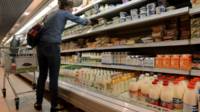- October 8, 2014
Share

The rating agency Standard & amp; Poor’s forecasts a sharp increase in food prices in Russia in the coming months due to the prohibition of imports of agricultural products from Western countries in response to the sanctions because of the events in Ukraine.
According to analysts of the agency, the rise in prices will be accelerated with the approach of winter. The main reason of this trend will be a shortage of products, the supply of which has been discontinued.
According to the agency, Russian companies will take some time for the conclusion of contracts with alternative suppliers.
“From our point of view, unexpected withdrawal of a significant proportion of agricultural products from the market is a “shock” from the food supply, which can only be partially mitigated by an increase in domestic production and imports from other regions (CIS countries, South America, Asia, and perhaps some of the European countries, not outside the EU), “- said in a survey released Wednesday by Standard & amp; Poor’s.
In August recorded a significant increase in prices of some food products that are covered by the ban. During August, the price of meat and poultry increased by 2.5% (in August of 2013 – just 0.2%). Fish increased by 1.4% (in 2013 – 0.7%). These trends continued into September.
The risk of stagnation
In response to the sanctions of the West, Russia in August imposed a one-year ban on the import of many types of agricultural products from United States, the EU, Norway, Australia and Canada.
As the ban put meat, fish, dairy products, vegetables and fruits.
These types of products account for nearly two-thirds of food consumption in Russia and about 19% of total consumer spending, according to a review of the agency.
Standard & amp; Poor’s also warned of the growing risk of prolonged stagnation in Russia: the deterioration of the situation, according to the analysts of the agency, primarily due to the international sanctions against Russia and response of the Russian authorities.
“We believe that the crisis may have negative impact on the prospects for economic growth in Russia (which has deteriorated due to the numerous structural problems) in the medium term as a result of weakening confidence in the Russian economy, the appreciation of the real and the perceived country risk and slow technological progress “, – the report says S & amp; P.
According to the forecast S & amp; P, the average annual GDP growth of Russia in 2014 will be about 0.3%. The agency downgraded Russia’s economic growth in 2015 from 1.7% to 1,1%.
In a recent report, the World Bank also promised the Russian economy stagnation, leading among the causes of the lack of structural reforms, economic uncertainty policies and geopolitical tensions caused by the deterioration of relations with Ukraine.
According to economists, the Russian economy is operating almost at full capacity.
The optimistic scenario of the World Bank provides a growth rate of 0.9% in in 2015 and 1.3% in 2016. In a worst case Russia expects recession.
According to forecasts Economic Development, economic growth in Russia this year will be 0.5%, in 2015 – 1,2%.
No comments:
Post a Comment